Part 2 of 2 Parts (Please read Part 1 first)
In order for the needed SMR paradigm shift to take place, industry and governments will need to strive towards standardized designs, standardized approaches to design requirements and standardized deployment and operating models.
Even if good progress is made towards harmonization and standardization, the successful, safe, and widespread deployment of SMRs depends on strong and appropriate oversight. Getting there will require international collaboration at a much deeper level than today. There will need to a be a commitment to meaningful progress and rapid change.
From an international regulatory perspective, international oversight must come from the International Atomic Energy Agency (IAEA). Member states of the IAEA will need to work together to ensure that the proper mechanisms are in place at the IAEA to support harmonization and standardization and ultimately the safety and security of SMRs around the globe.
For the nuclear industry, at a global level, international oversight means sharing information on deployment and operating experiences widely and openly. It also means ensuring peer reviews are supported and strengthened.
Governments need to have the political will to support SMRs. They must provide funding to regulators, industry and international organizations. And they must make the timely policy decisions required to enable successful deployment.
Ultimately, there will be no future for SMRs if there is no trust in the technology. The nuclear industry must dedicate itself to sincere, sustained, and substantive engagement, consultation, and trust building with members of the public, especially those communities hosting SMRs. In Canada, this is especially true with Indigenous Nations and communities in the context and spirit of reconciliation.
It is necessary for industry and governments to earn community trust and acceptance of the SMRs. They must make a strong case for SMRs. It is also necessary for regulators to build trust and confidence in regulatory decision-making and assure communities that strong and independent oversight will be there to keep them safe.
Nuclear energy does not emit carbon dioxide while reactors are operating. It is a well-regulated technology throughout its lifecycle. Although it is often feared and misunderstood. It could help diminish or prevent further impacts from the use of carbon dioxide emitting energy sources and provide energy security for many countries.
Unlocking the potential of SMRs will only be possible if there is a major paradigm shift in how the nuclear sector approaches deployment. Only through this fundamental shift will this technology be able to play a role that many think and hope it can be done in the timelines needed.
Regulators exist to ensure that SMRs are safe. However, it is every regulator’s role to monitor its industry, see where it is headed, and be ready to carry out its regulatory mandate efficiently and effectively.
Many see this paradigm shift coming and know that it will require much work from everyone including international organizations, governments, regulators, and industry. All must be focused on deploying a reasonable number of technologies.
The CNSC continues to show leadership in laying the enabling conditions through our efforts within Canada, bilateral cooperation with the U.S. and our work with the IAEA and NEA. The CNSC will continue to play an important role in enabling the safe, efficient and timely deployment of SMRs to meet Canada’s and the world’s needs.
